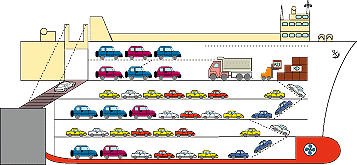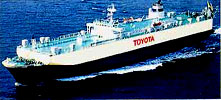Car / Motor Cycle Move
There are two ways to send your car.
One is to use one 20 ft or 40 ft ocean container, and the container will be loaded onto the container vessel.
Another way is to use a car carrier, without using the 20 ft/40 ft ocean container.


The comparison table for sending a car
| Advantage | Disadvantage | |
| 20ft/40ft container | Safe*1 Vessel availability once a week Can send personal items in the extra room.*2 | Expensive |
| Car carrier*5 | Cheap | Not safe *3 Vessel availability once a month Can't send personal item together with the car ※4 |
*1 As one container is only used by you, no other shipper can co-load, and therefore it is the safest way to ship.
*2 There will be some room in the 20 ft/40 ft ocean container, where you may place your personal items. Normally, a 20 ft container can hold up to a maximum total volume of 30 m3. A normal sedan car such as the TOYOTA CORROLA occupies 22 m3, therefore, the remaining space of approximately 8 m3 can be a used to contain personal items.
*3 A car must be surrendered with its key, and therefore, anyone would be able to open it. As the car is kept around the vessel side area, it is at great risk of having its parts stolen.
*4 A captain is not willing to accept your car containing personal items, as robberies have occurred during voyage. As such, the carrier will generally not accept your car containing personal items.
*5 Car carriers were originally developed for exporting new cars. However, since not as many new cars are being exported in recent years, we are able to make use of such car carriers. Motorbikes are not allowed on car carriers.

Motor-cycle in wooden-case

Car in container
Your ownership must have been for more than 12 months (6 months for UK, Australia, Germany, and a few other countries).
For customs clearance, a De-Registration Certificate is required in addition to the normal shipping documents.
To obtain a De-Registration Certificate, the following papers must be provided;
If your own "HANKOU" (personal seal) is registered:
- "SHAKENSHO"
- Power of Attorney
- Registration certificate (original) of your "HANKOU"
- Number plates of the vehicle
- Residence Certificate (if your present address is different from the address on the "SHAKENSHO")
If you do not have a "HANKOU" or it is not registered:
- "SHAKENSHO"
- Power of Attorney
- Registration Certificate of your signature (a Japanese translation must be attached)
- Number plates of the vehicle
- Residence Certificate (if your present address is different from the address on the "SHAKENSHO")
